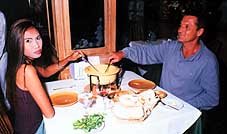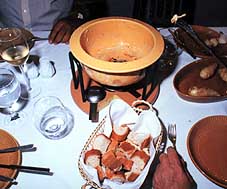Dining Out: Fassbind’s Fondue Corner - not just a meal, an educational experience!
Just how many ogling dens and beer boozers are there in Pattaya? Many people have asked the question and the figures vary wildly, anywhere from 1,000 to 4,000 bars if you include Naklua and Jomtien as well as the Thai karaoke and beer boozers. In truth, the number of bars catering primarily for foreigners run to around 50 ogling dens and about 600 outdoor and indoor beer boozers in the greater Pattaya area (Naklua down to South Pattaya and out to Third Road). Just take a close look at the latest Pattaya Nightlife and Restaurant Guide, a detailed street directory of the boozers and munching houses in Pattaya, and count the number of entertainment venues in each soi. The numbers of ladies who are gainfully employed in the town helping foreigners redistribute their wealth also varies wildly, from 10,000 to as many as 50,000. Most ogling dens employ an average of between 30 and 40 dancing maidens while the beer boozers can run from two or three drinks waitresses to 20 or 25 or more. Therefore, the real figure of employed ladies, as well as freelance artists, is probably around 12,000 to 16,000 rather than the fanciful and inflated figures expressed by some. Be a sport and come to the party: To celebrate the re-opening of the Sportsman’s Bar and Grill (Soi 13) the noshery/boozer will be having a party tonight, Friday November 23, with a free buffet and happy hour prices all evening. The Sportsman’s Bar and Grill (complete with a free pool table) is now fully air-conditioned and opens from 9 a.m. every day, closing when the last customer decides to stagger off home. Grand opening: The Stringfellas lounge lizard libation room and late night boogie barn (Prince Hotel, Soi 8) opened its doors a couple of weeks ago in a low-key operation designed to iron out any potential problems. On Saturday night November 24, Stringfellas will have its grand opening party, commencing at 8 p.m. A free European buffet will be provided, the Ritchie Newton ‘Elvis Presley Show’ will be part of the entertainment and, so I’m told, there will be up to 200 dancers, show girls and hostesses on hand to make your evening an ogling delight. Queen Victoria doing well: The new Queen Victoria Inn (Soi 6) is reportedly doing quite good business since it opened its doors just a few short weeks ago. After a few teething problems involving the nosh and the front door, the place has settled into a routine and is attracting a solid, regular clientele. Given the name of the boozer cum munching house it’s hardly surprising that the majority of punters are British. Three years on: The FLB lounge lizard libation room (Walking Street, just past the big tree) is celebrating its third anniversary with a party on Wednesday, November 28. The celebrations, organised by the London Clock, will kick off at 8:00 p.m. with a special pig roast and buffet. If previous FLB parties are any sort of yardstick then the place will be rocking and the girls liable to be rolling. The late night boogie barn recently installed a set of ice boxes to make sure that not only is the draft amber fluid a few degrees below zero but the bottled booze is also colder than an Eskimo’s armpit. For those who prefer slurping liver wasters, the FLB management certainly don’t skimp on the quantities with glasses the size of Mike Tyson’s fist and capable of packing a knockout punch. Up to me: The Watering Hole is among the new clutch of beer boozers and part-time nosh houses that have opened their doors in recent times in Soi Skaw Beach (off Second Road, just before the Made In Thailand Market). I’m told one of the attractions in the culinary department is the ‘Up To Me’ soup, lovingly prepared by the wife of mine host Lord Clive. The soup is advertised as a daily special and if anyone inquires as to its ingredients they are told it contains, “up to me”. I’ve been told it’s actually worth trying. My e-mail address is: [email protected]
by Ranjith Chandrasiri Italy is in many ways the ideal grape growing factory. A tradition of wine-making stretches back thousands of years to the Etruscans. It is the country with the largest wine output in the world. From the cool, Alpine climate of the north-east, to the baking heat of the far south, Italy has a variety of climatic conditions and soil types that are capable of a huge diversity of agriculture. All of this lies within ideal vine-growing latitudes, with a backbone of mountains and hillside slopes running the length of the country. Up in the north-west lies Piedmont, home of some of Italy’s greatest and most profound wines. Red wines made from the Nebbiolo grape, like Barolo and Barbaresco, are long-lived, complex, very serious wines. Traditionally these wines need long periods of cellaring before they reveal a core of intense fruit and a tremendous array of evocative flavours. A group of dedicated and quality conscious producers such as Batasiolo, Gaja, Aldo Conterno and Giacosa lead the field here, and although age-old traditions persist, some visionaries are pushing the boundaries to create less forbidding, more approachable styles. East of Piedmont, the Veneto is a vast area producing oceans of wine, much of it cheap and not particularly cheerful. Names are familiar to British wine lovers, like Valpolicella and Soave. There is excellent wine being made in this region, however. One of the keys is to look for the term “Classico” on the label. Soave Classico and Valpolicella Classico come from the superior hillside vineyards and are usually far removed from the expressionless versions made from grapes grown on the valley floor. Over on the Austrian border, the areas of Trentino and Alto Adige are making some flavourful, fresh white wines of high quality. In the centre of the country is Tuscany. This is the land of Chianti and of beautiful, rolling countryside, olive groves and cypress trees. Though a huge amount of plain, easy-drinking wine is made in the region, the best quality wines generally come from the Chianti Classico zone, stretching between Florence and Siena. These wines, at regular and Riserva levels, are usually reliable and can be breathtaking. Based on the Sangiovese grape, Chianti is normally a firm style of wine with a notable bitter edge, but plenty of ripe, cherry fruit and spicy, tobacco and herbal notes. The best producers, including Antinori, Castell’in Villa, San Felice and Isole e Olena, are making expensive but wonderful wines. These often include single vineyard grands vins, which scale the heights of world wine-making. There are some extremely interesting and inexpensive wines being produced in the south-eastern part of the country, from the Marches down to Apulia (Puglia) in the heel of Italy. Value for money favourites include Salice Salentino and Brindisi. Look for the wines of Taurino - amongst the best and most reliable names in the area. Some superb whites are also being made in the south, using New World techniques with cool, stainless steel fermentation. The local Greco grape makes lively and lemony-fresh wines of some distinction. An interesting range of wines which are unique to Italy are made with grapes dried in the warm air by laying them out on mats after harvesting. These recioto grapes make two basic styles of wine: Amarone, which is vinified to be dry and very alcoholic, and Recioto, where the fermentation is stopped earlier so that sweetness remains - though these are still deeply coloured, strong red wines. Something of an acquired taste, but look out for Amarones and Reciotos from producers like Alighieri, Masi and Allegrini. Along with the more classic Chianti and Barolo, the wines which perhaps point the way for the Italian fine wine industry are the “super Vini de Tavola”. These wines, mostly emanating from Tuscany, are made from a high proportion of international grape varieties like cabernet sauvignon or merlot. They are aged in new oak, and subjected to very non-traditional methods. For just as long as these wines have been breaking the rules, they have also been snapped up at high prices by international wine-lovers. They have helped put Italy back on the fine wine map and are wines of world-class quality. Names to look out for include Ornellaia, Tignanello and Sassicaia, but you’ll pay through the nose for them. Though I feel it would be a great shame for Italy to lose sight of its indigenous grape varieties and age-old methods (as long as these are kept under review to avoid stagnation), there is no doubt that such a prolific wine producing nation needs pioneers and standard-bearing wines to, hopefully, cause a rippling effect throughout the entire industry. Italy certainly has the raw materials to compete on the world wine stage at all levels. It is surely one of the areas to watch most closely. The good news is that you really don’t have to go as far as Europe to enjoy Italy’s exquisite wines and its famous cuisine. There is in fact a month-long Italian Food and Wine Fiesta at Royal Cliff Grand’s Rossini Restaurant in Pattaya. Aside from the superb Italian dishes and wines, there will be free Italian wine tasting for diners during the festival. Those who are really into Italian food and wine should take advantage of this special opportunity. Ranjith Chandrasiri is the resident manager of the Royal Cliff Grand, Royal Cliff Beach Resort, Pattaya, Thailand. Email: [email protected] or [email protected]
Updated every Friday. Updated by Chinnaporn Sangwanlek, assisted by
Boonsiri Suansuk. |
 Dipping
into the fondue
Dipping
into the fondue Fondue
Grandmother
Fondue
Grandmother